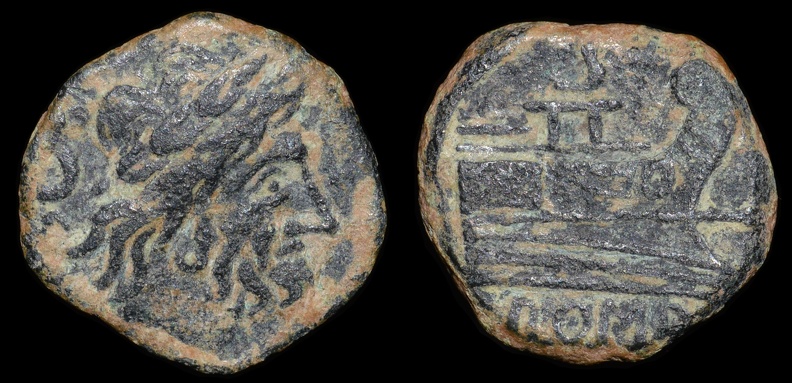
Indigenous imitations of Roman Republic coinage, Spain, Æ Semis(6.41g, 21mm). 150-100 B.C., Spanish mint. Laureate head of Saturn right, S behind/Prow of galley right; above, S; below, ROMA. Rippolès-Witschonke group C dies O28 R25
Purchased from Shanna Schmidt Numismatics at the Denver ANA World's Fair of Money 2017, 8/2/2017, ex an American collection formed in the 1990's.
This semis may at first glance look similar to a Roman Saturn/Prow semis, but it was not produced in Rome or even Italy. This style is only ever found in Spain and was almost certainly produced locally. The chronology, purpose and parties responsible for minting these semisses and other bronzes which imitated Roman types have long been discussed by Republican numismatists and even Crawford himself published a study of them but for many, myself included, they have remained a difficult area because of how little information was available. Thankfully in 2015 this changed dramatically when a paper by Pere P. Ripollès and the late Richard Witschonke was published which built upon existing literature combined with coins from various public and private collections and those in published hoards to perform a die study and analysis of these types. Rather than summarize their work here, I will discuss how this coin fits into the picture that Ripollès and Witschonke have painted and direct interested readers to read the paper in its entirety at this link. It requires you to login but it's free and you can use Facebook if you have one to avoid creating yet another separate login.
This particular coin fits into Ripollès-Witschonke group C, which included the largest number of recorded examples in their study and the second largest number of known dies. This coin was minted with obverse die 28 and reverse die 25, a die pairing not recorded in the paper but with such a large die sequence, not a surprising find either. At least 3 examples with this reverse die and many with other dies linked to it were in the Mengibar hoard, found in the Andalucía region in Southern Spain, and several examples from the RBW collection of similar style or even linked dies are reportedly of Andalucían provenance. This seems to suggest it was likely minted in the province of Hispania Ulterior, though it is of course hard to say for sure.
As far as dating, the authors of the paper linked above suggest this particular group was minted circa 150-100 B.C.. This is based on the group's heavier weight standard and hoard evidence that the latest Spanish imitations, minted on a much lower weight standard, were minted circa 80 B.C. and had been in circulation for a few years by the time of the Sertorian conflict.
This leaves one last major question: why were these coins minted? In Rome, bronze coins represented small change as opposed to the larger denominations minted in precious metals. It is generally assumed that these were minted to fit a similar role as many local mints were producing bronzes in Spain at the time(most not copying Roman designs) suggesting they were attempting to fill a great need for small change. The exact reason for the selection of Roman designs is not known, but I think it reasonable to assume that as Rome was the dominant power in the area, the easiest answer to the question "what does money look like" was "Roman money" for the people who minted these.